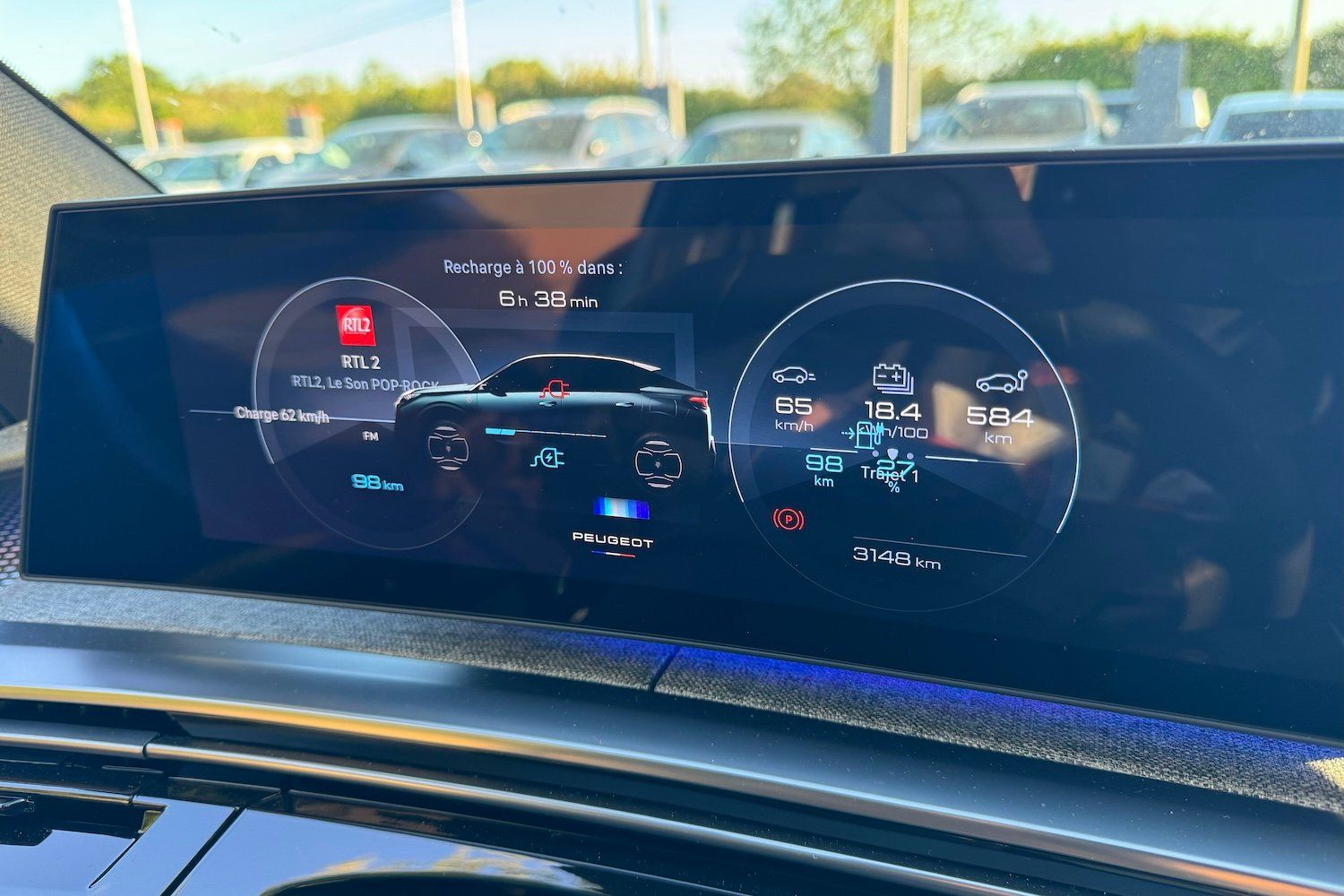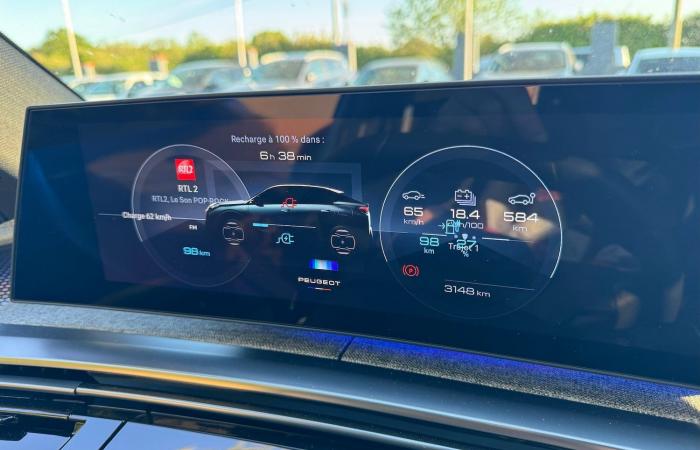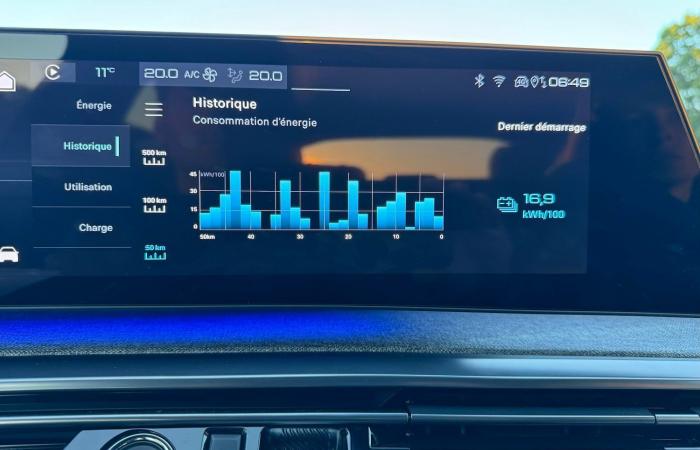After a relatively short first test of the Peugeot e-3008 in February, we couldn’t wait to get back behind the wheel of Peugeot’s 100% electric SUV. On the one hand to confirm the impressions felt during our first test, but also to be able to have a more precise overview of its consumption and its capacities in terms of autonomy.
The opportunity finally presented itself a few weeks ago. So we hit the road aboard the 73 kWh version of the e-3008, the only one available at the moment while waiting for a 98 kWh version planned in a few months. Objective: to reach the Atlantic coast from the Paris region and return of course, a route of around 1,000 km. Hidden objective: to see if the e-3008 is capable of completing this route calmly, with only one stop on the way out and on the way back.
It is on this mainly motorway route that we have carried out a good part of our “long distance” tests for several years and the first observation is that it is no longer necessary to program stops in advance of the trip. The vast majority of motorway rest areas on the route now have fast charging stations. Proof of this is that the charging infrastructure and the network of terminals in general are consolidating. That’s it for the parenthesis.
What is really going on with the electric 3008? How did he do on this route, certainly without any major difficulty, but still very highway-like?
Good sensations on board as long as you don’t touch the screen
We will not go overboard on the aesthetics of the e-3008. Obviously, this has not changed since our first test in February and neither has our opinion. If you want to know more about the design of Peugeot’s SUV, we invite you to reread our first test.
Read: our test of the Peugeot e-3008
On the other hand, what this longer handling allowed us to see was to what extent the interior, which we found very successful, could be pleasant to use on a daily basis. It’s undeniable, we are comfortable inside the e-3008 and even if we don’t have too much space, especially in the rear seat, the Peugeot star offers a fairly spacious environment and above all very pleasant to occupy.
We still really appreciate the new version of the iCockpit dear to Peugeot and in particular this curved screen which gives the impression of floating on the dashboard. Really, visually, inside this e-3008 is a success.
Unfortunately, it’s difficult to say the same about the OS part and the interface of the car, which is the obligatory step for anyone who wants to do anything other than turn the wheel or press the pedals. On this point, in addition to some rather surprising display bugs (superposition of several screens, refusal to return to the home screen or to validate certain commands) we encountered other problems on the interface more or less unfortunate. From CarPlay disconnecting unexpectedly to the route planner’s random calculations, the e-3008 often felt like it hadn’t been finalized on a software level. All this can be updated, of course, but to the extent that the SUV is already on the market, this reflects at least haste and at worst a lack of seriousness unusual for the Lion brand.

On this point, the performance of the route planner (when it accepts to operate) is symptomatic. Consequently, we chose to do without it in favor of a well-known alternative: the ABRP application. In other cases, this could have had some unfortunate consequences, particularly for the pre-conditioning of the battery. The e-3008 has nothing to worry about on this point, but not necessarily for the right reasons. It simply lacks a pre-conditioning function. On this subject, it should be noted that on Peugeot’s side, the position has evolved on this point and that the SUV should receive in a few months an update which will allow the battery to be preheated at least on the mains, before hitting the road. , a minimum.
Driving: a second, more conclusive test
Our first driving experience in the e-3008 gave us contrasting sensations. A few months later, this second attempt is not much different. It confirms this impression of heaviness, but nuances it greatly. Explanations. In an urban environment, despite its pachidermic dimensions and weight, the Peugeot SUV is helped by an excellent turning radius (10.6 meters) as well as its small double-flat steering wheel (characteristic of Peugeot) which allows it to be maneuvered more easily. easily than one would have thought. We also benefit from the three regenerative braking modes which allow us to recover a good dose of energy when we release the accelerator pedal. Adjustable using the paddles behind the steering wheel, these profiles allow you to choose the type of deceleration of your choice. This goes from a quasi-freewheel to a quasi-one Pedal via an intermediate mode which was most often our preference.
Despite its size, the e-3008 is particularly comfortable in town, which is a nice surprise. This ease in an urban environment is also found in terms of consumption, we will come back to this.
On the highway, this extra weight is even less noticeable, with maneuvering being much more limited. On the contrary, this seat gives the e-3008 additional comfort and it is undoubtedly in these conditions that the SUV is most comfortable. Especially since the engineers of the lion brand have done a very good job in terms of insulation. There is almost no noticeable noise up to 120 km/h. Beyond that, the breath of air is heard, particularly at the level of the amounts, but it still remains very well made. Ultimately, it is only on the secondary network, on national roads and winding departmental roads on which the e-3008 reminds us of its weight (2.2 tonnes).
On the other hand, there is one point on which Peugeot has considerably improved, which this 1,000 km test has regularly confirmed: driving aids (or ADAS). The e-3008, like many recent electric cars, displays a level 2 degree of autonomy. Like its competitors, the car integrates adaptive cruise control and lane keeping assistance which act in tandem. We used it for a long time, especially on traffic jams on the way back from our trip, and its contribution is invaluable. Above all, where Peugeot succeeds is in the dosage of this aid. Acceleration and braking are progressive, often on point, and you just have to leave your hands on the wheel and let the car do its thing to enjoy it. Even the overtaking assistance, which is validated after pressing a button, when conditions permit, gave us satisfaction. It still remains less practical than overtaking done “by hand”, but much more successful than many of the competitors who offer it.
Consumption: no surprise, but…
As a reminder, this first version of the Peugeot e-3008 has a 73 kWh battery, enough to allow a range of 527 km according to the WLTP cycle. Of course, on the highway, it is impossible to reproduce these values, but the question remains the same: how many kilometers can you travel with a charged battery?

That of the e-3008 is a Chinese battery with BYD cells for the moment. They will be replaced by French ACC cells by the end of the year, which should not change its capabilities. Let’s say it straight away, the e-3008 just passes the critical threshold of 300 km of autonomy on the motorway. During our test, we noticed a consumption slightly higher than 22 kWh on the outward journey, although the portions at 130 km/h lean towards a consumption of around 24 kWh. Still, between some portions limited to 110 km/h, others on which we were somewhat slowed down, our consumption allows us to affirm that it is possible to travel between 310 and 320 km on the motorway in e-3008.
Read: our match between French electric SUVs: Renault Scénic E-Tech Electric vs Peugeot e-3008
Our return trip, made on a day of fairly heavy traffic, does not allow us to confirm these first figures, but it gives others just as interesting to analyze. Including a few slowdowns at the toll gates and on the approach to Paris, our average speed of 108 km/h on the journey allowed us to see consumption of between 19.5 and 20 kWh/100 km. This is also close to the figures that we observed in mixed consumption (around 19 kWh/100 km).

The only small surprise in terms of battery usage is due to the urban consumption of the e-3008. By adopting an eco-driving style and playing the recovery game, we managed to reduce consumption in the city to 16.9 kWh/100 km. In this scenario, it is possible to envisage up to 450 km of autonomy.
Charging: not where the e-3008 shines the most
Talking about simple consumption would not make sense without mentioning trips to the terminal. On this point, let’s say it frankly, the Peugeot e-3008 disappointed us. On a domestic socket or a public 11 kW three-phase terminal, there are obviously no surprises. The actual charging sticks to what it should be in theory.
Things change when you connect the e-3008 to a fast charging station. During our two recharges, on this point the e-3008 fulfilled the objective that we had set for it, we never had the opportunity to approach the maximum power of the SUV when recharging, i.e. 160 kW. However, in both cases, we arrived at the terminal at the most opportune time, with a battery at 13% on the first recharge and 11% on the second. During the first session, our peak load never exceeded 116 kW and remained around 100 kW for a long time. During the second attempt, the charging power observed dropped again by a notch with a peak struggling to exceed 75 kW. Result of the races: charging sessions much longer than usual, around 50 minutes (compared to 30 normally) and a somewhat degraded journey.

©

©
Of course, before drawing definitive conclusions on the charging capabilities of the e-3008, it would be necessary to multiply the number of fast charges. But the fact that our two sessions conducted four days apart yielded mixed results in both cases is not encouraging.
Test verdict:
This second encounter with the e-3008 did not completely erase our first mixed impressions, but it still attenuated them. The e-3008 is a good electric SUV, despite its flaws, but arguably a somewhat disappointing 3008. This observation is not alarming as Peugeot had set the bar high with the thermal version which managed to provide great driving pleasure despite its size. Physically and structurally, the electric version is not capable of this feat, and while it must be acknowledged, it is also difficult to hold it against it as the technical challenge of integrating a battery weighing several hundred kilos is taken up. Our test on a long journey also confirms all the brand’s efforts to increase on-board comfort without compromising on autonomy, a challenge that the e-3008 ultimately meets. Peugeot has not been unworthy of this first version, but it will still have to face fierce competition embodied by the Tesla Model Y and its long-time rival, the Renault Scénic, in its electric version.
-
-












